#volkspolizei
Explore tagged Tumblr posts
Video
youtube
„Unsere Volkspolizei“ Marsch (1953)
Single-Schallplatte aus dem Jahr 1953. Orchester der Volkspolizei Berlin, Musikdirektor Willi Kaufmann: „Unsere Seepolizei“ / „Unsere Volkspolizei“. Label: Eterna – 104 287/88 mono (A039 / 073 S)
0 notes
Text
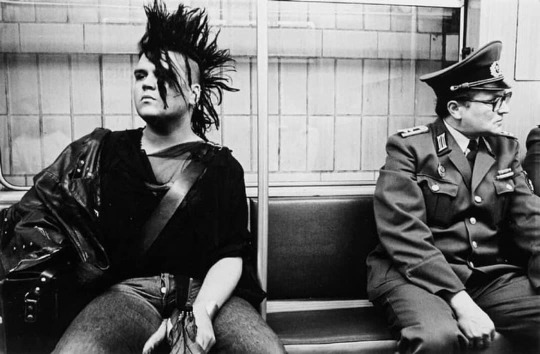
This fabulous 1986 image by Jörg Knöfel shows an East Berlin punk and the Volkspolizei ignoring each other. The punk, Sven Marquardt, would go on to have his face tattooed and become the city's most famous bouncer at Berghain
87 notes
·
View notes
Text
The PAUR War
Some silly thing I spent too much time on. Based on the Invincible Variants meme
In order of appearance: Mainverse / Leon / UnHeimat / Militsiya / Proselyte / Witchhunter / Imperial / Biker / 1st concept design / Corrupted / LEGO / SWAT / Anthro / Eldritch / T-One-Pfau-sand (T-1000)















Info on some of the variants:
UnHeimat: From a subterranean replica of the capital city of the Nation. Based on UnLondon.
Proselyte: From the SIGNALIS: Tactics universe. Betrayed the Nation to join Ariane's faction.

1st design: Based on PAUR's first concept design where he wore a Volkspolizei uniform and had a "hunk" physique. Those protrusions on his back are the legs of an autonomous robo-dog typically mounted on his back unless deployed.
Witchhunter: Originates from a (dark?) fantasy universe where gestalts and replikas can do magic, and supernatural monsters such as demons exist. Firearms development there is not up to par with the main-verse.
LEGO variant: Has no feet.

Eldritch variant: Under his cloak, his torso is a black void with demonic eyes surrounding it. This variant is based on comments by u/AssignmentExotic973 on r/SIGNALIS saying that replikas are technically eldritch spawns. And also based on the Escorts from an RPG Maker horror game called Underworld Capital Incident.
6 notes
·
View notes
Text

This fabulous 1986 image by Jörg Knöfel shows an East Berlin punk and the Volkspolizei ignoring each other. The punk—Sven Marquardt—would go on to have his face tattooed and become the city’s most famous bouncer at Berghain.
17 notes
·
View notes
Text
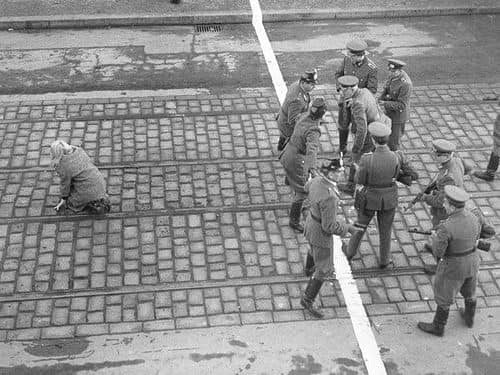
Young girl barely managed to cross the border between East and West Berlin in 1955 This famous photo is shared all over the internet as supposedly being made during the cold war in Berlin on the border between east and west and showing West Berlin policemen and East German Volkspolizei face each other while a woman has just crossed from one side to the other.
4 notes
·
View notes
Text

An East Berlin punk and the Volkspolizei ignoring each other in the U-Bahn. Photo by Jörg Knöfel.
3 notes
·
View notes
Text
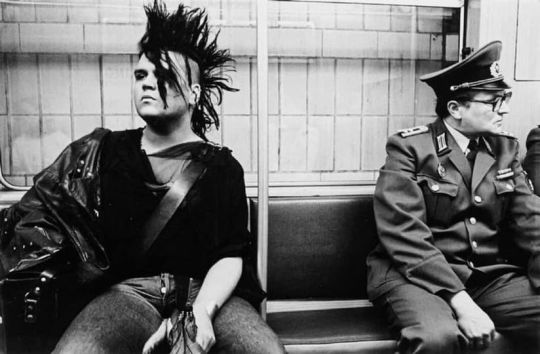
This fabulous 1986 image by Jörg Knöfel shows an East Berlin punk and the Volkspolizei ignoring each other. The punk—Sven Marquardt—would go on to have his face tattooed and become the city’s most famous bouncer at Berghain.
5 notes
·
View notes
Text
Berlin is divided
Shortly after midnight on August 13, 1961, East German soldiers begin laying down barbed wire and bricks as a barrier between Soviet-controlled East Berlin and the democratic western section of the city.
After World War II, defeated Germany was divided into Soviet, American, British and French zones of occupation. The city of Berlin, though technically part of the Soviet zone, was also split, with the Soviets taking the eastern part of the city. After a massive Allied airlift in June 1948 foiled a Soviet attempt to blockade West Berlin, the eastern section was drawn even more tightly into the Soviet fold. Over the next 12 years, cut off from its western counterpart and basically reduced to a Soviet satellite, East Germany saw between 2.5 million and 3 million of its citizens head to West Germany in search of better opportunities. By 1961, some 1,000 East Germans—including many skilled laborers, professionals and intellectuals—were leaving every day.
In August, Walter Ulbricht, the Communist leader of East Germany, got the go-ahead from Soviet Premier Nikita Khrushchev to begin the sealing off of all access between East and West Berlin. Soldiers began the work over the night of August 12-13, laying more than 100 miles of barbed wire slightly inside the East Berlin border. The wire was soon replaced by a six-foot-high, 96-mile-long wall of concrete blocks, complete with guard towers, machine gun posts and searchlights. East German officers known as Volkspolizei (“Volpos”) patrolled the Berlin Wall day and night.
Many Berlin residents on that first morning found themselves suddenly cut off from friends or family members in the other half of the city. Led by their mayor, Willi Brandt, West Berliners demonstrated against the wall, as Brandt criticized Western democracies, particularly the United States, for failing to take a stand against it. President John F. Kennedy had earlier said publicly that the United States could only really help West Berliners and West Germans, and that any kind of action on behalf of East Germans would only result in failure.
The Berlin Wall was one of the most powerful and iconic symbols of the Cold War. In June 1963, Kennedy gave his famous “Ich bin ein Berliner” (“I am a Berliner”) speech in front of the Wall, celebrating the city as a symbol of freedom and democracy in its resistance to tyranny and oppression. The height of the Wall was raised to 10 feet in 1970 in an effort to stop escape attempts, which at that time came almost daily. From 1961 to 1989, a total of 5,000 East Germans escaped; many more tried and failed. High profile shootings of some would-be defectors only intensified the Western world’s hatred of the Wall.
Finally, in the late 1980s, East Germany, fueled by the decline of the Soviet Union, began to implement a number of liberal reforms. On November 9, 1989, masses of East and West Germans alike gathered at the Berlin Wall and began to climb over and dismantle it. As this symbol of Cold War repression was destroyed, East and West Germany became one nation again, signing a formal treaty of unification on October 3, 1990.
2 notes
·
View notes
Link
0 notes
Text
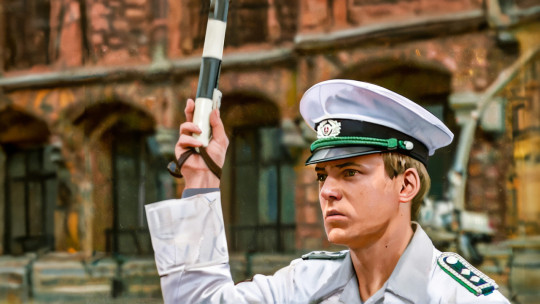
DDR Volkspolizei - Verkehrsposten mit Verkehrsstab, Berlin Mitte, Rathausstraße Kreuzung Spandauer Straße. (KI)
#Volkspolizei#Verkehrsposten#Verkehrspolizist#DDR#Berlin#Verkehrsregelung#Uniform#Polizei#Verkehrsstab
1 note
·
View note
Text
wenn die homosexuelle volkspolizei im umfeld des fuehrers weiter industriespionage versucht wird der nackte erich mielke mit seinen spitzeln zusammengebunden und von der skisprungschanze in oberhof gelassen
0 notes
Text
„… schlagt sie gleich tot“ Wie die DDR vor 75 Jahren einen Häftlingsaufstand niederschlug
Die JF schreibt: »Im März 1950 begann in der DDR-Haftanstalt „Gelbes Elend“ mit einem Hungerstreik der erste und größte Häftlingsaufstand des ostdeutschen Staates. Die Antwort der Volkspolizei war erbarmungslos. Dieser Beitrag „… schlagt sie gleich tot“ Wie die DDR vor 75 Jahren einen Häftlingsaufstand niederschlug wurde veröffentlich auf JUNGE FREIHEIT. http://dlvr.it/TJVtll «
0 notes
Text
By 1988, the average East German drank 142 litres of beer a year, double the intake of the average West German. The obvious explanation is they drank to escape the unbearable awfulness of being in the German Democratic Republic, with its omnipresent Stasi, clown-car Trabants, travel restrictions, gerontocratic rulers, grim Baltic holidays and laughable elections.
Not so, argues East German-born historian Katja Hoyer. Most East Germans drank not to forget their worries but because they had so little to worry about. She writes: “for those who wanted a quiet life with the small comforts of home it was a stable place with few concerns or worries”. By the late 1980s, true, the level of surveillance carried out by the Stasi was at an all-time high, but often it did little with the information gathered. In this, it was arguably less intrusive, certainly less effective, than today’s data-plundering techno-giants.
Not that Hoyer is an ostalgie-filled apologist. The GDR she describes is one divided between those “who resented the permanent state of alert and politicisation of life” and “others who craved meaning and belonging in contrast to what they perceived to be the empty consumerism of the West”.
Indeed, one way of reading Hoyer’s revisionist history is as a takedown of western hubris, using the example of East Germany to highlight our shortcomings in social mobility and women’s rights. Take childcare. In 1989, the GDR had one of the highest rates of female employment in the world, mostly because state nurseries, open from 6am to 6pm, admitted children from birth. But after the Berlin Wall fell, such expensively egalitarian services were dismantled and East German mothers found it difficult to square parenting with a career. As Hoyer puts it, they were “baffled when they had to justify why they even wanted both”.
As for social mobility, the GDR gave ordinary citizens chances that homologues raised in, say, Britain’s sclerotic public school plutocracy, can hardly aspire to. “Tens of thousands of young people from working-class backgrounds had been encouraged to study, promoted to leadership positions and given scholarships,” Hoyer writes. In 1953, when there was an uprising against the four-year-old GDR, many saw it as a threat to their new status. One consequence was the rise in voluntary security organisations such as the Freiwilliger Helfer der Volkspolizei (Voluntary Auxiliary of the People’s Police). An estimated 5,000 volunteers even helped defend the construction of the Berlin Wall in 1961, believing no doubt that their homeland, with all its opportunities, needed protecting and prepared to spend their free time doing so.
When Germany was divided into British, French, American and Russian sectors after the fall of the Third Reich, few expected the last one would become an independent nation, still less a walled-in Stasiland. “What is this GDR?” asked Stalin’s security henchman Lavrentiy Beria in 1952. “It’s not even a proper state. It only exists because of Soviet troops.”
True, Hoyer argues: Moscow saw East Germany as geopolitical pawn to be sacrificed if necessary in order to win the burgeoning cold war. Indeed, Stalin sought a reunified and neutral Germany as buffer between the socialist east and capitalist west. A year later, though, Stalin was dead, and Beria was executed with a bullet to the head, while East Germany would survive for another 37 years.
On October 7 1989, a four-year-old Hoyer and her father celebrated the GDR’s 40th anniversary with a trip to the viewing platform of Berlin’s Fernsehturm, the socialist-built TV tower. Below, police cars converged on Alexanderplatz in an attempt to quell the unstoppable protests that led to the collapse of the Berlin Wall a month later.
Like most East Germans, her dad had no inclination to join the demonstrators: the Hoyers were comfortable with their secondhand Trabant and two-bed flat in a 1960s prefab block. Today their daughter lives in the UK, but not without a memory of what died that day. What makes her meticulous book essential reading is not so much its sense of what East Germans lost, as what we never had.
0 notes
Text
Ende der Volkspolizei: Wie die Landespolizei MV entstand
1990 fiel der Startschuss für den Aufbau der fünf Länderpolizeien im Osten: ein harter Umbruch mit einer Entlassungswelle.
0 notes
Text
Thomas Heise
Zwei seiner Filme, Volkspolizei und Das Haus, gehören in die Grundausbildung aller Verwaltungsrechtler. War das der Sommer 2016 oder 2017, als er in Frankfurt Teile seiner Trilogie zu Halle-Neustadt (Stau..) und Vaterland vorführte und dann Rede und Antwort stand?
Als Manuela Klaut und ich das Festival des nacherzählten Falls in Weimar organsiert haben, da brachte Manuela, die ihn und seine Filme gut kannte, ins Spiel. Das Festival bestand aus einer Tagung zur Geschichte und Theorie der Kasuistik, also der Fälle und des Fällens, aus einem Wettbewerb und einem Filmprogramm (alles fand im Kino statt, knabbernd und denkend).
Wir haben damals Volkspolizei gezeigt. Vorher hatte ich eine Bildungslücke, kannte weder Heise noch seine Filme, danach habe ich alles verschlungen. Als Heise im Sommer nach Frankfurt kam, machte ich eine Lehrveranstaltung zum Thema Prozeßbeobachtung, wo wir uns mit Prozeßordnungen, Gerichtsarchitektur, Literatur und Film, damals vor allem NSU und forensic architecture befasst haben. Heise ist einer von denen, von denen man sofort sagen möchte, man hätte ihn gekannt, ihn getroffen, mit ihm etwas gemacht - und der kein Star und niemand mit zu verteilenden Mitteln oder Machtreserven war. Heise war einfach sehr begabt, dem drängte sich auf, was er zu tun hatte. Da gibt es nicht nur bei Heiligen den Kontaktdrang: man will etwas davon abhaben und erklärt sofort und so oft wie möglich, man sei ihm mal begegnet, habe ihn getroffen oder so. Es wäre gepimpt zu sagen, dass ich jemals mit ihm was gemacht habe. Aber wenn er zur gleichen Zeit vor Ort vor, saß ich da und habe versucht, alles aufzusaugen und ihn mir zum Beispiel zu machen.
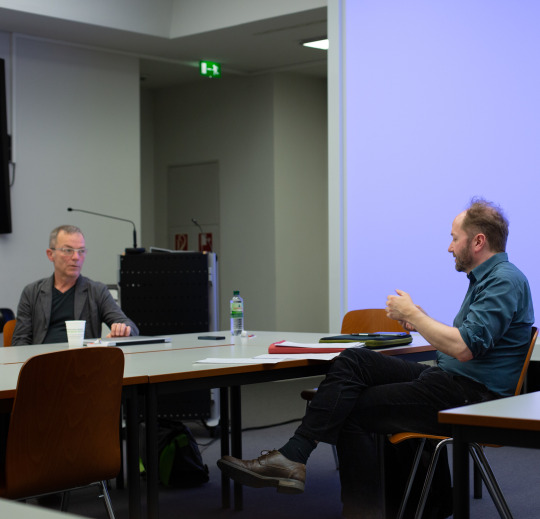
3 notes
·
View notes
